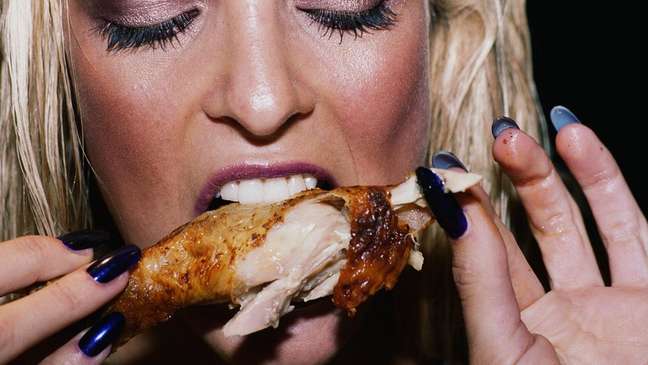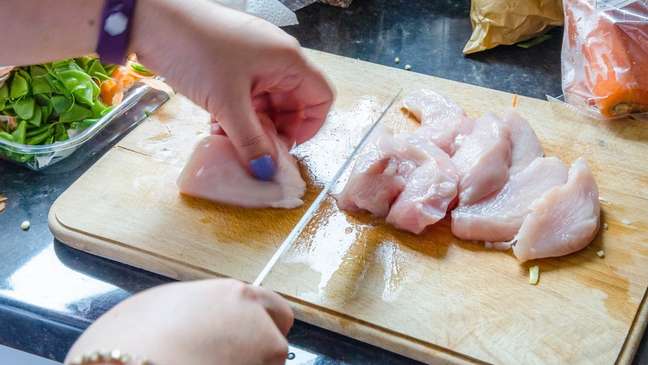This popular food, which is the main source of protein for many people around the world, appears to be surrounded by doubts and false beliefs.

Among animal meats, chicken is undoubtedly the world’s favorite.
It is the most consumed meat globally: the United Nations Food and Agriculture Organization (FAO) estimates that 133 million tons of white meat were consumed in the world in 2021.
In Latin America, the third most consumed region in the world, each person ate an average of 32.7 kg of chicken in 2019. The figure in Brazil was 40.6 kg and in Argentina 40.4 kg.
Eating chicken is popular because it is generally cheaper, low in fat, and encounters few cultural or religious barriers.
In addition, it is a meat rich in protein and an important source of vitamins and minerals. It still contains significant levels of beneficial monounsaturated fats, which can benefit cardiovascular health.
But even this popular food seems to be surrounded by doubts and false beliefs.
For example, chicken skin is known to contain a high level of fat. So, is it okay to eat chicken with the skin on or should we remove it before cooking or consuming the food?
“Chicken skin has 32% fat. In other words, for every 100 grams of skin we consume, 32 grams is fat,” said María Dolores Fernández Pazos, nutritionist at the Chicken Meat Nutrition Information Center ( Cincap, for its acronym in Spanish), to BBC News Mundo in Argentina.
Of these fats contained in chicken skin, explains the nutritionist, two thirds are unsaturated, the so-called “good fats”, which help improve blood cholesterol levels.
And a third of the fats are saturated, the so-called “bad” fats, which help raise unwanted cholesterol levels.

This is the same level of fat that chicken contains. Therefore, says the expert, “if we consume chicken with skin, we will increase the calorie intake of each serving by about 50%”.
So, for example, if we eat a 196-gram breast without the skin, we’re consuming 284 calories (according to U.S. Department of Agriculture Nutrition Data), with 80 percent of the calories coming from protein and 20 % from fat.
But those numbers soar if we include the skin: your breasts will have 386 calories, 50% protein and 50% fat.
Therefore, says nutritionist Dolores Fernández, “the healthiest and general recommendation for the population is to remove (the skin) before eating, so as not to add extra calories or fat to the plate.”
“In the case of people without a history of disease, with a weight appropriate to their height, physically active and with an adequate body composition, we can suggest leaving the skin of the chicken during cooking and removing it before eating it, given the presence of the skin. during cooking, cooking will help the meat dry out less and become juicier and tastier “, says the expert.
Can I refreeze thawed chicken?
“No. It is not recommended to refreeze chicken meat,” says Cincap’s nutritionist.
“The purpose of freezing food is to prevent microorganisms from growing on it. So when it thaws, those microorganisms can start growing again.”

And this is advice that applies to all meats that have been defrosted. The only safe way to refreeze them is when they are cooked.
“In this way, with safe cooking, we will eliminate the presence of microorganisms and we will be able to refreeze the meat, guaranteeing the organoleptic properties and safety of this product”, says Dolores Fernández.
What’s the best way to defrost chicken?
The best way to defrost chicken, experts say, is inside the refrigerator.
“Defrosting at room temperature can increase the growth of the microorganisms we talked about earlier and spoil the product.”
As defrosting in the refrigerator will be slower, it can take around 24 hours for a whole chicken. You need to plan ahead for the best time to take the meat out of the freezer.
Experts point out that chicken meat should never be thawed at room temperature or in hot water.
Why do some shops sell yellow and others pink chickens? Are some better than others?
The color of chicken meat can vary depending on the pigments contained in the grain used in its diet, explains specialist Cincap.
Grains such as corn contain a higher concentration of pigments than white sorghum or wheat.
And in some countries, in the preference of consumers, it is customary to add a natural pigment to poultry feed to give the meat a yellowish color.

But from a nutritional point of view, explains Dolores Fernández, “there are no differences between the properties and nutritional contributions of a yellow and a pink chicken”.
How to avoid poisoning with chicken meat?
Chicken, as seen, is one of the most nutritious and popular foods in the world, but it is also often a major source of food poisoning.
Raw meat is contaminated with Campylobacter bacteria and occasionally also with Salmonella and Clostridium perfringens.
That’s why if you eat chicken that hasn’t been cooked properly or contaminate other foods or drinks with raw chicken or its juices, you can get food poisoning.
The US Centers for Disease Control and Prevention (CDC) estimates that around 1 million people in the country get sick from eating contaminated poultry each year.

These are the basic tips from the experts at the Chicken Nutritional Information Center:
-Always wash your hands before preparing any type of food and several times during its preparation, especially if you handle raw and cooked foods at the same time;
-To avoid cross-contamination: when handling chicken and other raw foods, use different equipment and utensils and avoid contact with cooked and / or ready-to-eat foods;
– We must never wash chicken meat, as this can cause, together with the water particles they spray, to contaminate the workplace;
– Cook the chicken completely: it must be devoid of the pink color inside or near the bones and joints;
If you have chicken left over from one meal and want to eat it the next, reheat it completely.
Source: Terra
Benjamin Smith is a fashion journalist and author at Gossipify, known for his coverage of the latest fashion trends and industry insights. He writes about clothing, shoes, accessories, and runway shows, providing in-depth analysis and unique perspectives. He’s respected for his ability to spot emerging designers and trends, and for providing practical fashion advice to readers.







